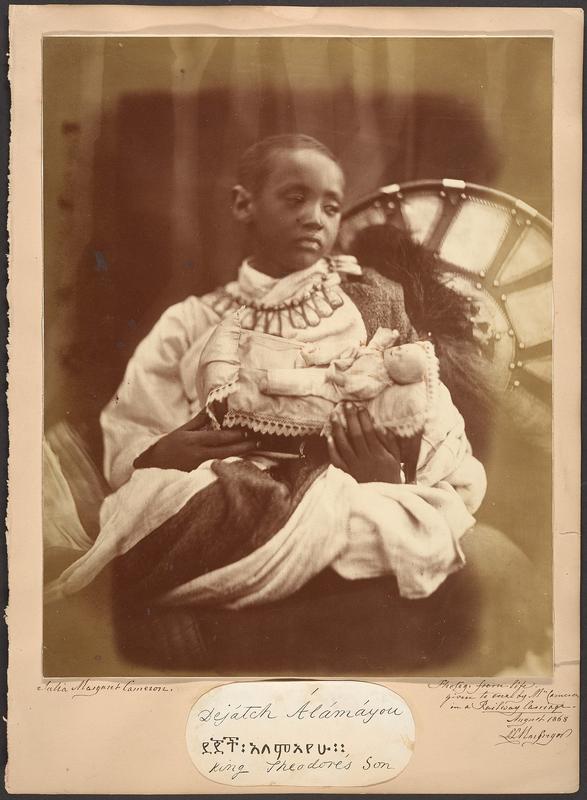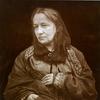More about Déjatch Alámayou, King Theodore's Son

Contributor
When it comes to Julia Margaret Cameron’s photos of Déjatch Alámayou, the history is everything.
Unlike Cameron’s goofy photos, like the ones dressing her husband up as Merlin, or her more referential, allegorical work like Zoe Maid of Athens, this photo is entirely haunting due to the long, brutal story that precedes it.
Emperor Tewodros II of Ethiopia found himself in the midst of a series of rebel uprisings in 1868. He wrote a desperate letter to Queen Victoria asking for her to send British forces to assist him in quelling the rebellion. She ignored the letter, preoccupied with imperialistic ventures in an effort to trade with the Ottoman empire and feeling that she had little to gain by helping him.
When Victoria didn’t respond, Emperor Tewodros II held hostage the next British missionary who showed up at his palace. When a British consulate came to try to convince him to let the missionary free, Tewodros II held the consulate and his team hostage as well. This sparked the beginning of a violent and vengeful response by the British. The British Bombay Army, led by Lieutenant Napier, marched into Ethiopia, which was previously uncharted territory for the British. 13,000 British and Indian troops struggled across the land with the assistance of 45 elephants to carry their weapons, spending heaps of money along the way to feed the troops.
The British claimed to have tried to negotiate for their hostages first, and when Tewodros refused, they then marched to Magdala to lay siege. They defeated Emperor Tewodros II’s army quickly and violently, and he committed suicide with a pistol to avoid capture. Meanwhile, the British troops aggressively looted gold, silver, brass, filigrees, crowns, and rare tabots from the palace and churches. An Ethiopian royal chronicler, Alaqa Walda Mariam described the siege saying, “The English troops rivaled one another in "shooting down" any Ethiopian seen carrying spears or guns, and when anyone was seen taking up a weapon, he was shot.” They laid down mines and burned Magdala, the capital, to the ground as they departed. The British troops also kidnapped the emperor’s seven-year-old son, the depicted Déjatch Alámayou, and brought the boy (and everything they’d looted) back to Britain.
Upon their arrival, Queen Victoria suddenly felt bad for the child, so she sent money to him and assigned Captain Tristram Speedy to look after and educate him. Speedy brought Alámayou to Cameron’s home that same year and she photographed him. The darkness and loneliness on Alámayou’s face is haunting as he holds a white doll and stares off into the distance.
Sadly, the boy would go on to die of pleurisy at the age of eighteen.
Sources
- “‘Déjatch Alámayou, King Theodore's Son July 1868.’” Accessed July 9, 2020. https://www.metmuseum.org/art/collection/search/286351.
- “Dèjatch Alámayou & Básha Félika / King Theodore's Son & Captain Speedy: Cameron, Julia Margaret.” Accessed July 9, 2020. http://collections.vam.ac.uk/item/O1394113/dejatch-alamayou-basha-felik….
- K, Mehek. "British Museum Returns Emperor's Hair!" Youngzine, March 21, 2019. Gale General OneFile (accessed July 9, 2020). https://link-gale-com.libproxy.newschool.edu/apps/doc/A580017430/ITOF?u….
- Pankhurst, Dr Richard. “Maqdala and Its Loot.” AFROMET - The Association for the Return of The Maqdala Ethiopian Treasures, 2008. https://web.archive.org/web/20081206014422/http://www.afromet.org/histo….
- Rahman Alfa Shaban, Abdur. “UK Museum to Return Lock of Hair of Ethiopia's Emperor Tewodros II.” Africanews. Africanews, March 4, 2019. https://www.africanews.com/2019/03/04/uk-museum-to-return-lock-of-hair-….











